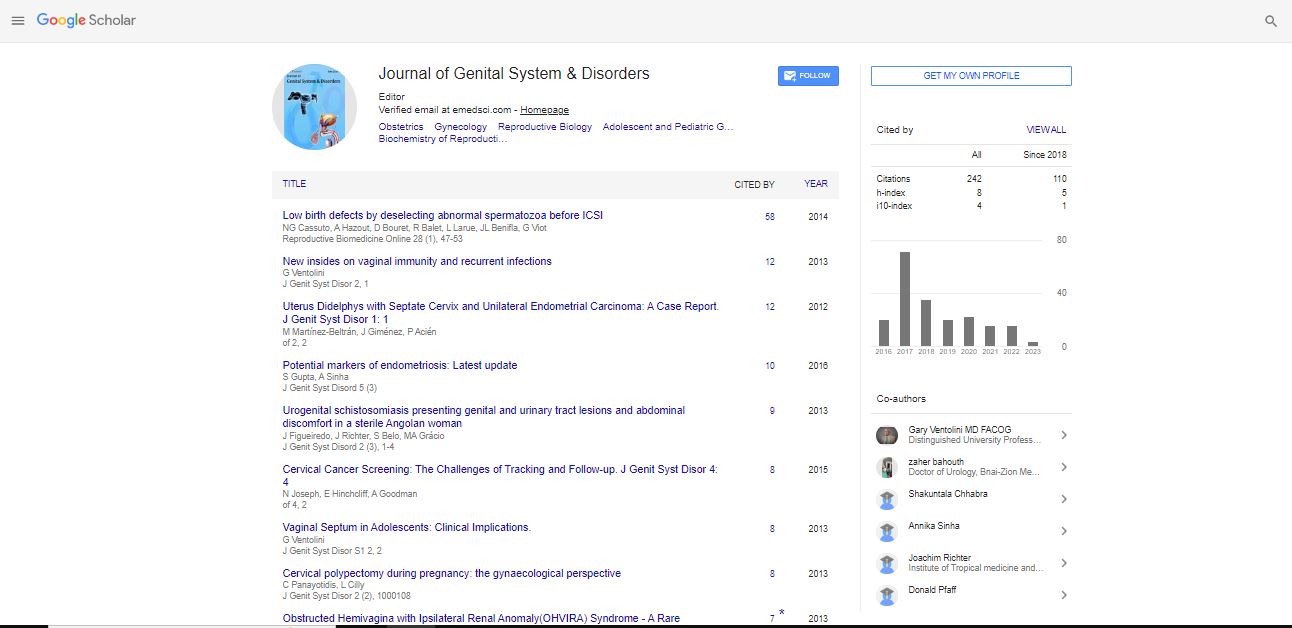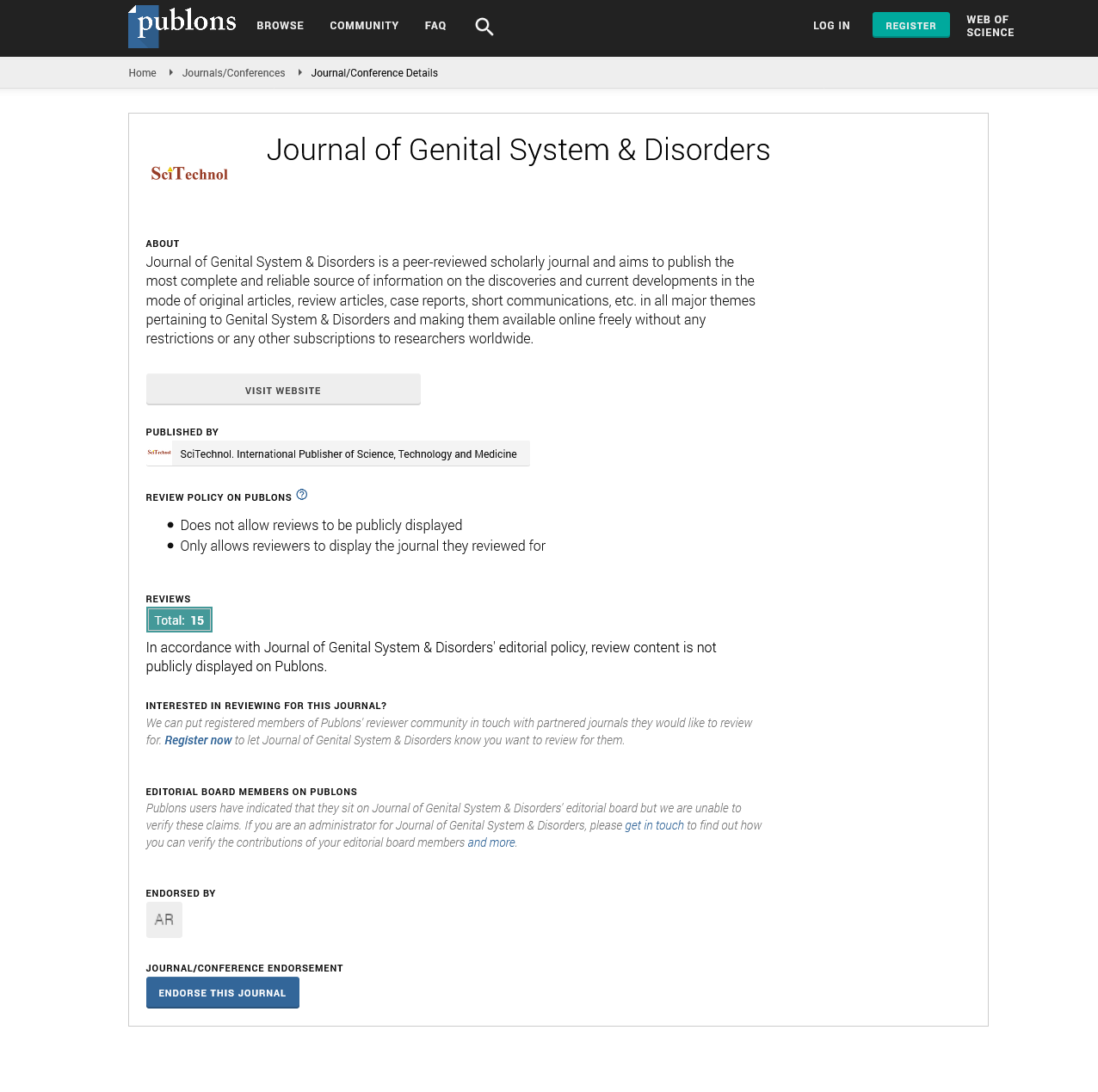Perspective, J Genit Syst Disord Vol: 12 Issue: 2
Urogynaecology: Addressing Pelvic Floor Disorders and Female Urinary Incontinence
Bolis Stuart*
1Department of Obstetrics and Gynaecology, University of Witwatersrand, Johannesburg, South Africa
*Corresponding Author: Bolis Stuart,
Department of Obstetrics and
Gynaecology, University of Witwatersrand, Johannesburg, South Africa
E-mail: stuart.bolis@hotmail.com
Received date: 22 May, 2023, Manuscript No. JGSD-23-107300;
Editor assigned date: 24 May, 2023, PreQC No. JGSD-23-107300(PQ);
Reviewed date: 08 June, 2023, QC No. JGSD-23-107300;
Revised date: 16 June, 2023, Manuscript No. JGSD-23-107300 (R);
Published date: 26 June, 2023 DOI: 10.4172/2325-9728.1000278
Citation: Stuart B (2023) Urogynaecology: Addressing Pelvic Floor Disorders and Female Urinary Incontinence. J Genit Syst Disord 2023, 12:2.
Description
Urogynaecology is a specialized field within gynaecology that focuses on the diagnosis and treatment of pelvic floor disorders and female urinary incontinence. Urogynaecology encompasses the evaluation, diagnosis, and management of pelvic floor disorders, including urinary incontinence, pelvic organ prolapse, and other related conditions. Pelvic floor disorders affect a significant number of women, often resulting from childbirth, hormonal changes, age-related factors, or other contributing factors.
Anatomy and function of the pelvic floor
The pelvic floor is a complex structure consisting of muscles, ligaments, and connective tissues that provide support to the pelvic organs, including the bladder, uterus, and rectum. The muscles of the pelvic floor help control urination, defecation, and sexual function. Proper coordination and strength of these muscles are essential for maintaining continence and pelvic organ support.
Types and causes of pelvic floor disorders
Urinary incontinence: Urinary incontinence is the involuntary leakage of urine and is a common pelvic floor disorder affecting women. Stress Urinary Incontinence (SUI) is characterized by leakage during activities that increase abdominal pressure, such as coughing, sneezing, or exercising. Urge Urinary Incontinence (UUI) involves a strong and sudden urge to urinate, resulting in leakage before reaching the toilet. Mixed Urinary Incontinence (MUI) refers to a combination of both stress and urges incontinence. Various factors contribute to urinary incontinence, including pregnancy and childbirth, hormonal changes, obesity, and pelvic floor muscle weakness.
Pelvic Organ Prolapse: Pelvic Organ Prolapse (POP) occurs when the pelvic organs, such as the bladder, uterus, or rectum, descend and protrude into the vagina. It can cause a range of symptoms, including a sensation of vaginal bulge, pelvic pressure, urinary or bowel dysfunction, and sexual discomfort. POP commonly results from weakened pelvic floor muscles and connective tissues, often associated with childbirth, aging, or genetic predisposition.
Diagnostic and treatment modalities
Accurate diagnosis and appropriate treatment are crucial in urogynaecology. Diagnostic approaches include medical history assessment, physical examination, urodynamic studies, imaging tests, and specialized questionnaires to evaluate symptoms and quality of life impact. Treatment options depend on the type and severity of the pelvic floor disorder, patient preferences, and overall health. Conservative management strategies may include lifestyle modifications, pelvic floor exercises (Kegel exercises), and the use of vaginal pessaries. Surgical interventions, such as pelvic reconstructive surgery, sling procedures for SUI, or hysterectomy for POP, may be considered in cases where conservative measures are unsuccessful.
Multidisciplinary approach and patient centered care
Urogynaecology necessitates a multidisciplinary approach, involving gynaecologists, urologists, physiotherapists, and other healthcare professionals. Collaboration among specialists helps provide comprehensive care, considering the complexity of pelvic floor disorders and their impact on different aspects of a woman's life. A patient-centered approach, including shared decision-making, counseling, and education, is vital for addressing the unique needs and goals of each patient. It promotes holistic care, aiming to improve symptoms, restore function, and enhance quality of life.
Conclusion
Urogynaecology is an essential field that addresses the diagnosis and management of pelvic floor disorders and female urinary incontinence. Understanding the anatomy, function, types, and causes of pelvic floor disorders is crucial for healthcare professionals to provide comprehensive and effective care. By employing a multidisciplinary approach and patient-centered care, healthcare providers can optimize treatment outcomes, improve quality of life, and empower women in managing their pelvic floor health. Continued research and advancements in urogynaecology will further enhance our understanding and refine treatment options for these prevalent conditions.
 Spanish
Spanish  Chinese
Chinese  Russian
Russian  German
German  French
French  Japanese
Japanese  Portuguese
Portuguese  Hindi
Hindi 
